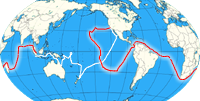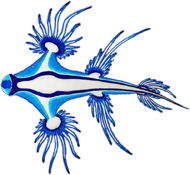Because of strong winds out of the southeast the anchorage in Nosy Hao was getting a little uncomfortable. So we decided to change to the island of Nosy Hara where there really is the only sheltered anchorage in this area and it is also the main part of the national park. When we went ashore at one of the sandy beaches a very friendly ranger came to us to welcome us on his island. Next to French he was also able to speak some English and explained that this is a national park and therefor we should kindly pay the entrance fee. Then he told us to come visit the main part of theisland because there is a lot to see like snakes, birds, geckos and even a chameleon. The island is not very big but we were looking forward to what he would be able to show us.
The next day we went ashore and the ranger went with us on a trail into the small forest. It is a well prepared 750 meter long walkway through the forest and the ranger right away showed us some brightly green colored geckos sitting on the trees. Those are Madagascar giant day geckos (Phelsuma grandis) which live on the trees and are approximately 20 cm long. Then there were some brown colored bigger wood geckos sitting on the trees or in small holes in the trees. They are colored like the tree barks and wait for some prey to come by. Next to the trail we again and again saw some snakes between the leafs. In the tree tops there were many birds playing around. The most beautiful one being the Flying Catcher, a bird of paradise with a long white tail and a dark blue cap on the head. It is a Madagascar paradise fly catcher (Terpsiphone mutata) which weighs only about 13 grams and has an extreme gender/sex dimorphism. This means that the female birds have a rusty red color, a black head above the eye and a blue ring of skin around the eyes. The male ones the blue ring is wider and they have a long white tail feather. They are either colored white or rusty red and can be found in Madagascar as well as the Comores. Furthermore we discovered the Madagascar or Malagasy cuckoo (Centropus toulou) hiding in the tree tops. He really was very frightened and we could not get a good picture of him.
We were surprised how many different animals we were able to see on this really small island. After a while our guide the ranger asked us if we also want to see the chameleon. Of course we do! So he vanishes between the bushes and trees with a small stick in his hands and starts to search close to rocks on the floor. We wanted to help so we asked him what size we have to look for. He pointed to the top of his finger and said approximately this size! This was really tiny and now we know that indeed it is the smallest chameleon of the world - Brookesia micra. After a while he found one and showed us this dwarf which as an adult grows to a size of a little more than 15 millimeters. On the next day we looked for one ourselves and were lucky to find a female one. They are camouflaged very well and sit under lots of leaves on the forest floor. The female ones are lighter in their brown coloring than the male ones. From the tip of their tail they grow to a size between 23 and 29 mm (females tend to be bigger). Like other chameleons they can partly change their color, mainly into different shades of brown and even almost white. According to their first scientific description they can not change their color. But we have seen it with our own eyes. It is a fantastic animal, so tiny but still a real vertebrate with all it needs. It is the smallest reptile of the world. It was not found until 2007 and finally described 2012 by zoologists from Munich, Germany. They only live in the dry forests of Nosy Hara, which means they are endemic to this island.
Next to the forest trail there is also a 3 km long hiking trail along the tsingy-formations. The towers made of limestoe layers are called tsingy and are typical for Madagascar. From up there you have a beautiful view of the bay as well as the surrounding islands and can observe all the turtles in the water. Here you often encounter one of the rarest bird of preys in the world – the Madagascan fish eagle (Haliaeetus vociferoides). The loud shriek can be heard across the bay already in the mornings. It is a critically endangered bird and there are only 120 breeding pairs, approximately 360 birds, left in the world. In the Nosy Hara area we saw a few of them as well as in Maramba Bay, which is further to the south.
Even if you are not traveling by sailing boat you should visit this island if you are in the area and spend some days there. It is possible to camp and there is a beautiful as well as healthy coral reef surrounding the island.





.jpg)








.jpg)
.jpg)

















.jpg)






 >>planned route - join us ...
>>planned route - join us ...